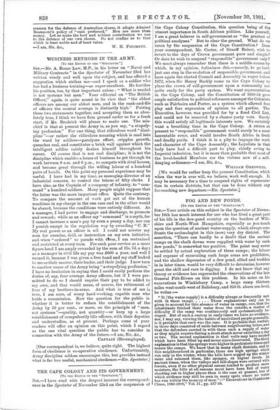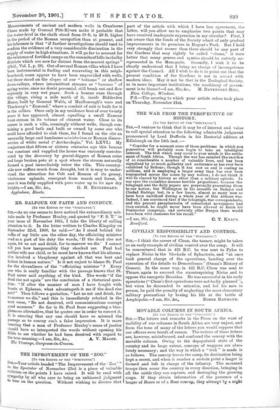FOG AND DEW PONDS. [To THE EDITOR OF THE "SPEOTATOR. "]
SIR,—Your article on this subject in the Spectator of Novem. ber 16th has much interest for one who has lived a great part of his life in the dew-pond country on the borders of Wilt- shire and North-West Hampshire, especially as you touch upon the question of ancient water-supply, which always con- fronts the archaeologist in this (now) very dry. district. The assertion, "There can hardly be a doubt that the ancient camps on the chalk downs were supplied with water by such dew ponds," is somewhat too positive. The point may never be settled by actual exploration of these camps; the labour and expense of excavating such large areas are prohibitive, and the shallow depression of a dew pond, silted and trodden in in later times, would be very difficult to determine, however great the skill and care in digging. I do not know that any theory or evidence has superseded the observations of the late General Pitt-Rivers on this problem. In his notes on his excavations in Winklebury Camp, a large camp thirteen miles west-south-west of Salisbury, and 850 ft. above sea-level, he writes :— " It [the water-supply] is a difficulty always or frequently met with in these camps. . . . . . Three explanations only can be given to account for this absence of water in camps, one, that the inhabitants fetched their water from the outside, a matter of difficulty if the camp was continuously and systematically be- sieged. But of such a custom in early times we have no evidence, nor, I may say, viewing the habits of uncivilised people generally, is it probable that such was the case. It is probable that warfare in those days consisted of raids between neighbouring tribes, and that the defenders carried in with them such a supply of water as they might require during a short attack never exceeding a day or two. The second explanation is that wells may have existed which have been filled up and never since discovered. The third explanation is that the springs were higher in prehistoric times and nearer the camps. We know that in many chalk districts, and in this neighbourhood in particular, there are high springs !Inch run only in the winter, when the hills have sopped up the winter rains and retained them, like sponges, at higher levels. In ancient times, when the valleys and hill-slopes were covered with forests, even if no other physical causes tended to produce more moisture, the hills at all seasons must have been full of water shooting out in higher places than is the case at present, but of which evidence may still be seen in many spots where no water has run within the memory of man."—" Excavations in.Cripaborne Chase, 1880.1888," Vol. II., pp. 237-38. measurements of ancient and modern wells in Cranborne Chase made by General Pitt-Rivers make it probable that the water-level in the chalk stood from 30 ft. to 50 ft. higher in the period of the Roman occupation than at present, and his inference is that "if further investigations should tend to confirm the evidence of a very considerable diminution in the supply of water in high situations, it will go far to account for the existence of fortified camps on the summits of hills in chalky districts which are now far distant from the nearest springs " (Did., Vol. I., p. 28). Out of several Roman villas which I have been instrumental in finding and excavating in this neigh- bourhood, some appear to have been unprovided with wells, but these stood on the slopes of our " bottoms " or shallow down-valleys, where intermittent streams or " hearties " of spring water, once no 'doubt perennial, still break out and flow copiously in very wet years. Such a bourne runs through this village, rising a mile north of it, inside Biddesden House, built by General Webb, of Marlborough's wars and Thackeray's "Esmond," where a conduit of exit is built for it in the cellars. Once only in my residence here of over twenty years it has appeared, almost equalling a small Exmoor trout stream in its volume of clearest water. Close to its course is such a villa, seemingly without wells, though con- taining a good bath and built or owned by some one who could have afforded to sink them, for I found on the site an unusually large and handsome ministeriurn or Roman dinner.. service of white metal (" Archmologia," Vol. LX1TL) My conjecture that fifteen or sixteen centuries ago this bourne was constant and supplied the house was curiously corrobo- rated by the discovery by gravel-diggers of Roman coins and large broken pots at a spot where the stream naturally formed a pool immediately below the villa. This country- side now suffers much from drought, but it is easy to under- stand, the attraction for Celt and Roman of its grassy, wholesome uplands, emergent from marsh and forest, if once it was fully supplied with pure water up to its now dry















































 Previous page
Previous page